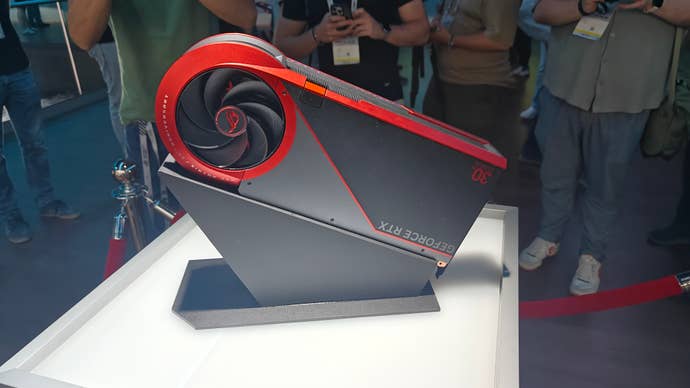As well as a see-through 720Hz tandem OLED gaming monitor, Asus unveiled a retro-looking graphics card that draws up to 800W – a massive 200W jump over the most powerful RTX 5090 models and 215W over the base spec. A single 16-pin power cable maxes out at 600W, so the ROG Matrix uses both the proprietary BTF connector built into Asus motherboards and the regular 16-pin power input. That should make this the most powerful consumer graphics card in the world by a huge margin, and just how it’s been designed is fascinating.
In short, Asus wanted to pay homage to their past designs with a 30th anniversary edition that goes well beyond the standard “take your standard GPU and paint it differently” method of creating special models. That accounts for the unusual circular frame of the far end, which refers back to a card Asus launched in 2008, but inside there are also manufacturing and design elements from later models: 3mm copper PCBs, vapour chamber cooling, liquid metal, four fans and so on.

Perhaps most critically for the super-wealthy slash overclocking audience the limited edition card is intended for, there are sensors on every wire of each power input to ensure that none is drawing too much power – after all, with 800W on tap, this is effectively uncharted territory for a “stock” graphics card.
There’s even a sensor to check the angle of the card, alerting you if it’s starting to sag. Graphics card enthusiasts actually spotting the sensor in other high-end Asus models a while back, and now that functionality is actually going to be surface in Asus’ software.
So with 33 percent extra power, you’re going to get 33 percent extra performance, right? RTX 5090 Ti, more or less! Well, no. Asus say that the graphics card only delivers around 10 percent higher frame-rates, even at a rated boost clock of 2730MHz – versus 2407MHz for a base 5090. It’s not clear if there are any memory clock upgrades on offer either, but the GDDR7 on Maxwell does tend to overclock without many difficulties.
Of course, an 800W rating far exceeds this generation’s power sweet spot – and presumably even with unlimited power, you’d still run into some serious issues keeping the die, tiny mainboard and VRAM/power components cool under an 800W load.
It does kind of suggest that this is about the maximum we could expect from a proper RTX 5090 Ti though, which is perhaps why Nvidia hasn’t shown any signs of releasing one.
Even if you do have deep pockets, expect the ROG Matrix 5090 to be a real challenge to find. Asus say that only 1000 units will be made, though you can enter the chance to win one on their Gamescom 2025 site. Pricing also hasn’t been announced, but presumably is well into the middle four figures given that a dead standard 5090 costs $2000 or more, even so many months after launch.
More numerous – and affordable – will be their special edition 5080 models, which include a Hatsune Miku edition (part of a distractingly large number of branded peripherals and components) and a Noctua edition with the Austrian firm’s famous fans.
Either way, I’m happy the Matrix 5090 exists, pushing out the state of the art to ludicrous excess. It’ll be fascinating to see what overclockers manage to accomplish with it – bring on the liquid nitrogen! – and the retro design really appeals. I just hope that this GPU doesn’t portend the arrival of a 800W-rated RTX 6090.
Disclosure: Asus provided flights and accommodation in Cologne for Gamescom.






